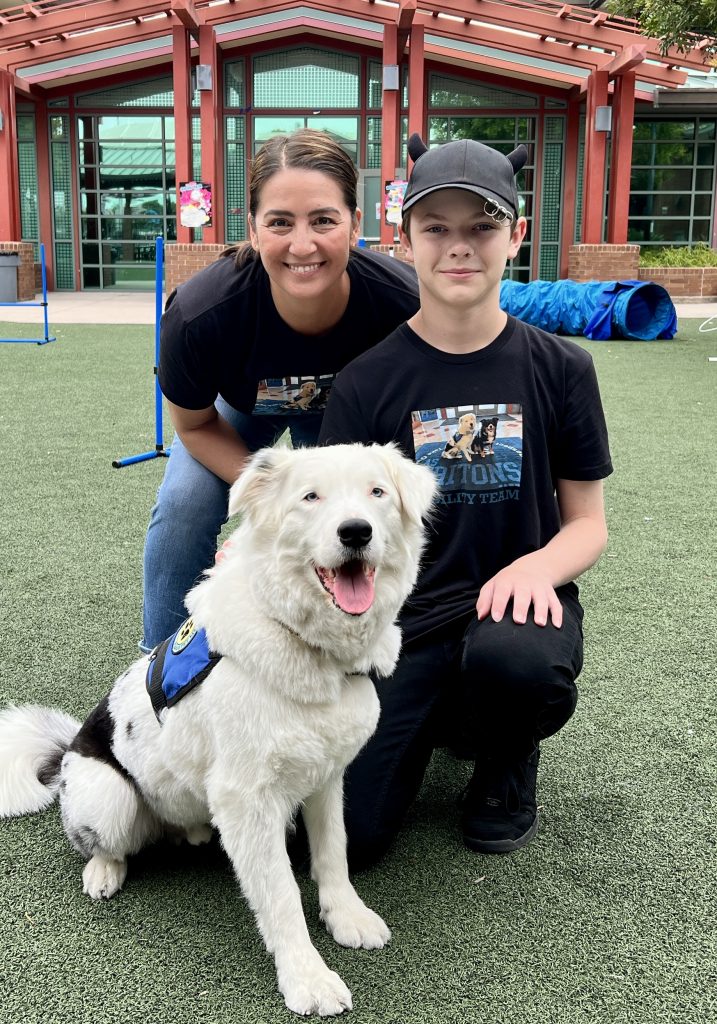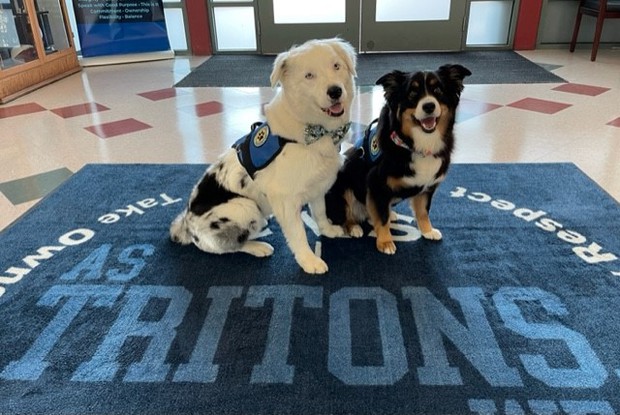A Coronado mom and her son are rallying to save the therapy dog program that changed his life.
Regina Sebring, mother of three, says that Coronado Middle School’s Therapy Dog Program was a game-changer for her son Bryson, who has ADHD and Autism Spectrum Disorder. Bryson, who is in seventh grade at CMS, struggled with communication and flexibility. Sometimes he was unable to share how he was feeling with teachers.
“He used to be really withdrawn and he had trouble talking to anyone,” said Sebring. “He had a lot of fears.”
Sebring said that he was very closed in and wore the same clothes to school every day. He wore a COVID mask long after the pandemic ended and was very rigid in his routine.
But the therapy dog program, initiated by clinical counselor Rebecca Rabe, changed everything.
“It’s made such a huge difference in his life,” said Sebring. “Now he’s outgoing and he’s funny, and he’s learned appropriate ways to socialize. He’s really come out of his shell.”

But now that could be coming to an end. Rebecca Rabe, along with other counselors, program specialists, a Spanish teacher and a maintenance worker may be cut as the district faces a $2.3 million budget shortfall.
If Rabe gets cut, the therapy dog program will leave with her.
That’s bad news for Bryson and kids like him who rely on the program to help them connect and find success in school. Sebring says that the program — in its third year — began with five kids, and has grown to serve 47 students. That includes 18 students in special education and seven English language learners, according to Sebring.
Declining enrollment and exhaustion of COVID monies are contributing to the district’s budget crisis, but the main driver is the change in the state’s projected Cost of Living Adjustment (CoLA). The CoLA was originally projected to be 3.2%, but was changed to .76%, according to Maria Simon, spokesperson for CUSD
That represents more than $1 million in decreased funds for CUSD.
Simon said that resizing can be difficult, but even with the cuts, the district will continue to meet the needs of all students and provide a high-quality academic education in a safe and inclusive environment. She also shared that, even with potential cuts, the district will still have more counselors on staff than they had prior to COVID.
She said that prior to the pandemic, CUSD had the equivalent of 12.08 full-time counselors on staff. The district used one-time COVID money to hire more counselors in the wake of the pandemic, bringing that number up to 16.75. But even with the cuts, the new number of counselors–projected to be 13.55–is higher than the pre-pandemic number, with about 300 less students.
“It’s important to note that CUSD has much lower ratios than the county average,” said Simon. “While we boosted our number of counselors for a defined period of time during and immediately after the pandemic, we are still committed to providing above the average counseling support for our students.”
The American School Counselors Association recommends a ratio of 250 students per counselor; after cuts the ratio at CUSD will be 202 students per counselor. According to the San Diego County Office of Education, averages across the county range from 400 to 600 students per counselor.
“Not only are our student/counselor ratios better than most districts, but CUSD provides access to additional mental health resources for our students and families via CareSolace, a mental health concierge service that is free to all CUSD staff and families, Military Life Counselors, and our strong partnership with Safe Harbor,” said Simon.
But for kids like Bryson, the ratios might not mean much. Sebring says he, like many other kids, relies on the therapy dog program to help him get through his day.
“Neurodivergent kids really struggle with nuance, and they struggle with the implied meaning behind things and with social cues, so it’s really important for them to have a solid relationship with a counselor that they can connect to,” said Sebring. “Because that’s what taught him that school was a safe place, and there are people he can go to when he doesn’t understand those things.”

Rabe, who is a clinical counselor with CMS, is also certified in Animal Assisted Human Health Certification Therapy. Rabe uses research-based practices to facilitate the interactions with students and she shared that the dogs (there are two now, Miso and Mushu) are used in different manners; from helping students de-stress throughout the day by petting during passing periods and breaks, to emotional support during one-on-one counseling when students are often overwhelmed, according to a 2022 news release from CUSD.
Sebring says that given the teen mental health crisis and epidemic of childhood depression and attempted suicide, counselors are needed now more than ever.
Bryson, with the help of his parents, started a grass-roots effort to inform kids and parents that the therapy dog program was in trouble. He handed out flyers at school and launched a website, SaveCUSDCounseling.com. Sebring says she hopes that the district will take more time and review all options to do what’s best for students.
“Have the problems of the pandemic gone away? I don’t think so,” said Sebring. “I understand that the budget is the budget, and they have to find money somewhere, but I don’t think this is a place you can pull it from.”
Simon says that the district is looking towards Basic Aid, whereby the district will be funded by local property taxes in 2026-2027.
“Of course any program that was previously cut will be at the top of the list for consideration and evaluation when funding increases,” she said.
But Sebring says that the Therapy Dog Program is something that kids like Bryson need right now, today. And sometimes, it’s just that one special thing that gets a kid to school and keeps him coming back, day after day.
“When you’re a student and you’re depressed or you’re struggling in school, sometimes it’s the hope of that one happy moment, and it gets you through the day and keeps you coming back,” said Sebring. “If you can save one kid, it’s worth it.”

dogs are on the CMS campus to help support student and staff wellness. Image: CUSD




